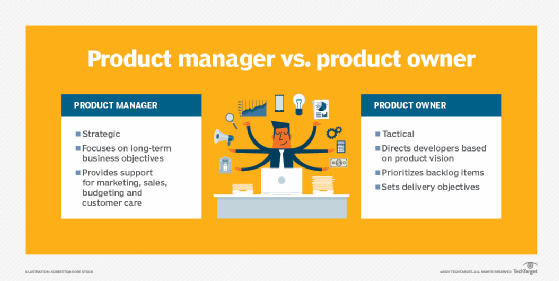
Getty Images/iStockphoto
Product owner vs. product manager: What's the difference?
The job a product manager does for a company is quite different from the role of product owner on a Scrum team. Learn key differences between a product owner and product manager.
Difference between product owners and managers
The key difference between a product manager and a product owner is that the product manager is responsible for the entire product development lifecycle, while the product owner position only exists during a Scrum-based development cycle.
There's no standardized criteria that defines the responsibilities of a product manager. Generally, any person in the product manager role is entrusted to maintain the vision for a given product, widget or app for which they oversee development. That means:
- The product manager must understand the current capabilities of the application they currently oversee.
- The product manager must know what the app should be capable of in the future.
- The product manager must remove any blockers that stand in the way of the vision becoming reality.
What are common product manager tasks?
A product manager performs many tasks to build the product vision and remove blockers that impede progress. Some common tasks include:
- performing competitive analysis,
- conducting feasibility studies,
- fighting for budget money and funding,
- analyzing user feedback,
- establishing success metrics and
- overseeing product testing and deployment.
In contrast to the product manager, a product owner's job is much more limited. It's also more rigorously defined.
What does a product owner do?
According to the Scrum Guide, the product owner ensures that the development team always works on the highest-priority features that aren't impeded by serious blockers. In Scrum and Agile terminology, blockers are issues that halt progress and delivery until they are resolved. Impediments are issues that slow but do not stop the team's progress. Bugs typically don't impede work on a feature, and may actually prioritize that work.
Following the Scrum Guide, the product owner must:
- communicate the product goal to the Scrum team;
- define product backlog items for the Scrum team;
- prioritize the features to be created by the Scrum; and
- ensure product backlog items are visible, transparent and understood.
The Scrum Guide further states that a development team is capped at 10 participants. This limits a product owner's scope to what a group of 10 developers could produce over a given timeframe.
Product managers, product owners and Scrum
Key factors that define the role of a product owner in Scrum include:
- A product owner only exists during a Scrum-based development cycle.
- A product owner's duties are defined entirely by the Scrum Guide.
- A product owner makes development decisions independently.
The Scrum Guide requires the product owner to make decisions about product features independently and without oversight. The organization also must wholeheartedly accept the product owner's competency within their domain.
In contrast, a product manager may be expected to be more collaborative in their decision making.

Can product managers be product owners?
On small Agile projects, the product owner and product manager may be the same person.
In such instances, the product manager splits their time between the Scrum-based development team, C-suite executives and other stakeholders to move their vision of the product forward.
On larger projects, the product manager may oversee many product owners. In this situation, the product manager is a separate role from the accountabilities the Scrum Guide demands of the product owner.
On projects that don't use Scrum, there are no product owners at all.
That's the biggest difference between a product owner and a product manager. The product owner is bound to the Scrum-based software development framework, while the product manager isn't.
Product owners vs. managers, in summary
Any organization that builds a product has a product manager. The position and title can be officially assigned or simply understood throughout the organization.
In contrast, any team that does Scrum must have a product owner as it's a Scrum framework requirement. Outside of Scrum, the role of the product owner doesn't exist. If an organization stops doing Scrum, they no longer have any product owners. A product manager continues to exist even if Scrum isn't in use.






